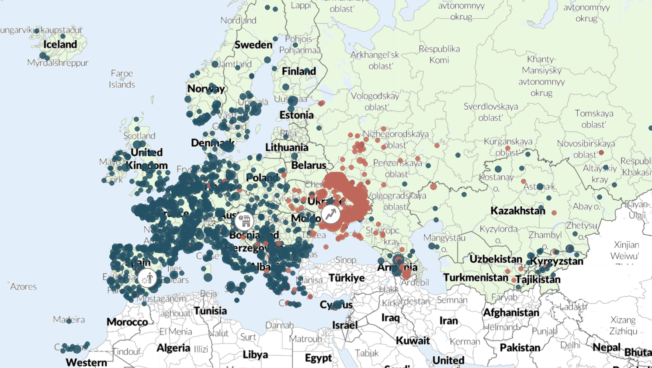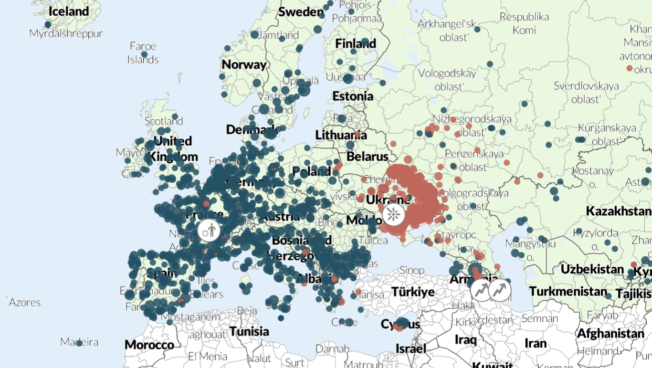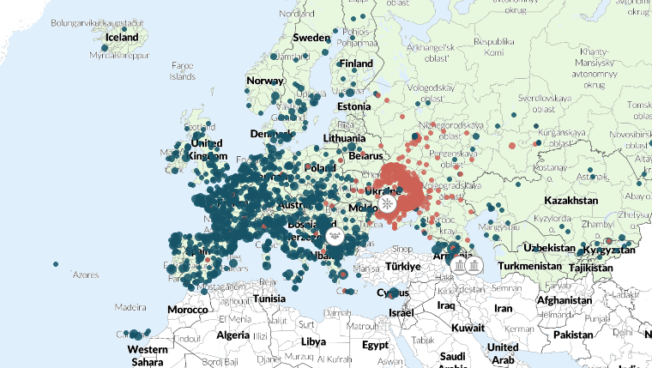Regional Overview
Europe and Central Asia
June 2025
Posted: 5 June 2025
In this Regional Overview covering May 2025
- Europe: Pro-Palestine protests sweep across the continent
- Europe: Russia-linked incidents keep up pressure across the region
- Russia: Waves of Ukrainian drones strike deep into Russia
- Spain: A former Yanukovych associate gunned down near Madrid
- Ukraine: Russia intensifies offensives amid renewed peace talks
Europe: Pro-Palestine protests sweep across the continent
Thousands of people took to the streets across Europe in May to support Palestine and denounce Israel’s latest operations in Gaza, which have seen the most extensive and intense airstrike campaign since December 2023. ACLED records at least 370 related demonstrations across the continent — the highest number since October 2024, which marked a year since Hamas’ attack on Israel and the subsequent Israeli offensive on Gaza.
The largely peaceful demonstrations demanded an end to the Israeli offensive and appealed to European leaders and institutions for action, including activists entering the Ministry of Finance building in Oslo to demand a withdrawal of Norway’s Oil Fund investments from companies linked to Israel. Demonstrations peaked on 1 May for Labor Day and around the 77th anniversary of the Nakba (Catastrophe) on 15 May, marking the beginning of the mass displacement of Palestinians around the foundation of Israel and ensuing Arab-Israeli war. The region’s largest rallies were recorded in the Netherlands, with 100,000 people gathering in The Hague on 18 May,1Reuters, “Tens of thousands protest in The Hague against Gaza war,” 18 May 2025 and in London, with up to an estimated half a million people marching on 17 May.2Tom Watling, “Pro-Palestine protesters march on Downing Street for Nakba anniversary,” Independent, 17 May 2025 Demonstrations turned violent on a few occasions, including in Berlin, where clashes at a pro-Palestine rally resulted in over 50 arrests and the injury of both demonstrators and police officers.3Matt Ford, “Germany: Dozens injured at Berlin pro-Palestinian protest,” Deutsche Welle, 16 May 2025
Renewed civil society mobilization over the Israeli offensive on Gaza coincided with what seems to be a policy shift within European Union institutions. On 20 May, despite the opposition of eight member states, including Germany, Italy, and Hungary, EU countries approved a Dutch proposal to review the EU-Israel Association Agreement, citing human rights violations.4Institute for International Political Studies, “EU-Israel Relations Face Scrutiny amid Escalating Gaza Conflict,” 29 May 2025 Israel accused the EU of “a total misunderstanding of the complex reality Israel is facing” in return.5Euronews, “Israel ‘completely rejects’ EU decision to review trade and cooperation deal,” 21 May 2025 On the same day, the United Kingdom announced that it had suspended free trade talks with Israel.6Gavin Blackburn, “UK suspends trade talks with Israel and sanctions West Bank settlers,” Euronews, 20 May 2025
Europe: Russia-linked incidents keep up pressure across the region
Suspected Russian destabilization activities appear to be picking up again across Europe. The uptick follows a relative lull in early 2025 in the wake of United States President Donald Trump’s election and indications that Russia might test US diplomatic pressure on Ukraine and its allies. ACLED records at least seven incidents in May, including arson and foiled sabotage plots, in addition to increased tensions in the Baltic Sea.
In the UK, a string of arson attacks on properties linked to the prime minister between 8 and 12 May prompted investigations into Russian involvement.7Amy-Clare Martin, “UK officials ‘probe Russian links to arson attacks on Keir Starmer,’” The Independent, 25 May 2025; Brian Melley, “Russia denies involvement in arson at properties linked to UK Prime Minister Starmer,” The Associated Press, 26 May 2025 In Germany, prosecutors called out a Russian-backed sabotage operation after the arrest of three Ukrainians for scouting freight routes with GPS-tracked parcels intended for explosive attacks.8Felix Tamsut, “Germany arrests 3 for planning Russian ‘sabotage’ attacks,” Deutsche Welle, 14 May 2025 In France, although no official connection to Russia had been made yet, investigators were looking into foreign involvement after several Jewish sites were targeted with green paint in Paris on 30 and 31 May.9Le Monde, “Paint thrown at Jewish sites: the three men arrested are Serbian,” 3 June 2025 (French)
For its part, the Baltic Sea was home to fresh tensions between Russia and European countries. On 14 May, a Russian fighter jet intercepted an Estonian military helicopter, preventing it from boarding an oil tanker believed to be part of Russia’s “shadow fleet,” used to circumvent sanctions on Russian oil.10BNS, “Estonian Navy attempts to intercept tanker believed to be part of Russia’s shadow fleet,” Postimees, 15 May 2025 On 20 May, Russia responded to Estonia’s failed operation by briefly detaining a cargo ship that used a designated transit channel through Russian territorial waters to leave the Estonian port of Sillamäe.11Reuters, “Russia releases oil tanker from Baltic Sea detention, Estonian broadcaster says,” 20 May 2025 The row follows a string of events since late 2024, where tankers allegedly linked to Russia have been involved in damaging fiber optic and power cables in the Baltic Sea. Estonia also reported a continuing dispute with Russia on buoys demarcating their shared border on the Narva river and blames Russia for stealing marine research buoys.12BNS, “Estonia Calls Off Buoy Discussions with Russia After Year of Failed Diplomacy,” Postimees, 30 May 2025; BNS, “Russian navy steals Estonian university’s wave buoy,” Postimees, 26 May 2025
For more information on suspected Russian activity across Europe, see ACLED’s latest report Testing the waters: Suspected Russian activity challenges Europe’s support for Ukraine.
Russia: Waves of Ukrainian drones strike deep into Russia
Ukraine carried out several waves of drone attacks deep into Russian territory in May. On 2 and 3 May, a wave of nearly 100 drones swarmed Russia, focusing on the country’s southern regions and reportedly aimed at targeting naval infrastructure.13New Voice Ukraine, “Russia reports massive drone strike on Novorossiysk, home to Black Sea Fleet base,” 3 May 2025 (Russian) While no damage to naval facilities was confirmed, a Ukrainian naval drone downed a Russian fighter jet over the Black Sea on 3 May, in the first recorded event of its kind in modern warfare.14H. I. Sutton, “World First: Ukrainian Maritime Drone Shoots Down Russian Flanker Jet,” Naval News, 3 May 2025
Between 6 and 8 May, Ukrainian forces sent new barrages of drones, likely aimed at disrupting the Victory Day parade in Moscow on 9 May and dissuading attendance at the event. Russia claimed to have intercepted over 300 drones, although some hit an airfield in the Moscow region and others a military plant in Saransk in the Mordovia republic. The drones led to the temporary suspension of operations at some Russian airports,15Meduza, “Russian airlines return to normal schedule after airport collapse,” 8 May 2025 (Russian) which complicated the travel of several foreign leaders attending the parade.16BBC, “Serbian President’s Plane Makes Emergency Landing in Baku on Way to Moscow,” 7 May 2025 (Russian) Ukraine ramped up its attacks again after 21 May, likely in retaliation for large Russian drone strikes on 18 and 25 May (see the Ukraine section below).17Yevgen Kizilov, “Zelenskyy promises Russia mirrored responses to its attacks – video,” Ukrainska Pravda, 27 May 2025 Aside from the border regions of Belgorod, Bryansk, and Kursk, strikes were reported in 11 regions of Russia, and hit several industrial facilities, including three drone and missile plants, a battery plant, and two chemical plants. The strikes preceded a series of drone attacks on four military airfields in the Ryazan, Murmansk, Ivanovo, and Irkutsk regions on 1 June that may have destroyed a dozen Russian bomber and surveillance jets.18Laura Gozzi, “How Ukraine carried out daring ‘Spider Web’ attack on Russian bombers,” BBC, 2 June 2025
Spain: A former Yanukovych associate gunned down near Madrid
On 21 May, unidentified gunmen shot dead pro-Russian Ukrainian exile Andriy Portnov outside a private school in a Madrid suburb. Portnov served as deputy chief of staff to Ukraine’s former President Viktor Yanukovych, who lives in Russia after his ouster in February 2014. He is believed to have interfered with the Ukrainian judiciary and masterminded legislation aiming to suppress the Euromaidan unrest in early 2014,19Eugene Buderatsky et al., “Devil’s lawyer. What is known about the murder of Portnov in Madrid and what he was doing in the last years of his life,” Ukrainska Pravda, 21 May 2025 (Ukrainian) which Russia used as a pretext to annex Crimea and covertly invade the Donetsk and Luhansk regions. The motive for the attack remains unclear. Despite a recent spate of assassinations of prominent pro-Russia Ukrainians carried out or instigated by Ukrainian special services, in addition to the targeting of Russian top military and defense industry figures, Ukraine denied involvement, suggesting a Russian false flag operation. Reports suggest that Portnov’s debt issues may have also played a role.20Yaroslava Tymoshchuk, “Political crime or financial debt? New details, versions and circumstances of Portnov’s murder in Madrid,” RFE/RL’s Ukrainian service, 22 May 2025 (Ukrainian); Oleg Pavlyuk and Tatiana Oliynyk, “The Foreign Ministry commented on the murder of Portnov in Spain,” Ukrainska Pravda, 23 May 2025 (Ukrainian)
The killing is the latest of several high-profile events that have taken place in Spain since Russia’s full-scale invasion of Ukraine in 2022. On 11 February 2024, unidentified perpetrators killed Maxim Kuzminov — a former Russian helicopter pilot who defected to Ukraine on 9 August 2023 and lived under a false identity in Valencia province. Spanish intelligence services posited then that the Russian government may have hired contracted assassins. Further suspected hostile Russian activities in Spain included at least six flammable parcels sent in late 2023 to Spanish government officials, an arms producer, and Ukrainian and US diplomats posted to the country. Furthermore, likely Russia-linked arsonists set ablaze a warehouse owned by a private Ukrainian company near Madrid on 30 March 2024, shortly after the company’s other facility in east London caught fire. In addition, in July 2024, Spanish police arrested three Spanish nationals suspected of carrying out cyberattacks in coordination with the pro-Russian hacking group NoName057(16) targeting the websites of Spanish defense, interior, and foreign ministries, as well as two defense companies and the Bank of Spain.
Ukraine: Russia intensifies offensives amid renewed peace talks
Following failed indirect ceasefire negotiations and Russia’s continued refusal to commit to an unconditional 30-day ceasefire, Ukraine and Russia held their first in-person meeting since 2022 on 16 May in Turkey. Earlier, Ukraine rejected Russia’s unilateral ceasefire from 8 to 11 May, which Moscow likely sought to improve security during its Victory Day parade on 9 May. The talks in Istanbul led to one of the largest prisoner exchanges between the two countries,21The Guardian, “Ukraine and Russia complete ‘1,000 for 1,000’ prisoner exchange,” 25 May 2025 but they failed to lead to a ceasefire or any other agreement on the battlefield, as Russia refused to budge on its maximalist demands. Russia insists that Ukraine give up the entirety of the five regions of Crimea, Donetsk, Kherson, Luhansk, and Zaporizhia, including parts currently controlled by Ukraine, under threat of a prolonged war.22Mary Ilyushina, Serhiy Morgunov, Siobhán O’Grady and Ellen Francis, “Russia takes tough stance in Istanbul talks, threatens Ukraine with long war,” The Washington Post, 16 May 2025 Despite limited progress, the delegations continued talks in June.23Veronika Melkozerova, “New Russia-Ukraine talks yield another large POW swap — but no ceasefire,” Politico, 2 June 2025
On the ground, Russia increased military pressure on Ukraine. Russia launched record-high barrages of 273 drones on 18 May,24Lucy Davalou, “Russia deploys 273 drones in biggest attack on Ukraine yet,” Euronews, 18 May 2025 367 drones and missiles on 25 May,25Max Hunder and Jeff Mason, “Russia launches war’s largest air attack on Ukraine, kills at least 12 people,” Reuters, 26 May 2025 and 472 drones on 31 May.26Abbey Fenbert, “Russia shatters drone record, launches 472 UAVs at Ukraine night before Kyiv’s strike on Russian airfields,” The Kyiv Independent, 2 June 2025 It also intensified strikes on Kyiv city and the surrounding region. Meanwhile, Russia continued to press Ukrainian defensive positions on the frontlines. ACLED records an upward trend in the number of armed clash events in Ukraine since February, with Ukrainian military analysts confirming a sizable increase in Russian daily attacks in May compared to April.27Ivan Diakonov, “Russia increased assaults by 19% in May compared to April – DeepState,” Ukrainska Pravda, 2 June 2025 Grinding battles in the Donetsk region in May led to Russian advances in all key directions, with Russian troops seizing nearly a dozen settlements and reportedly briefly entering the Dnipropetrovsk region.28Yevheniia Martyniuk, “Russians said they crossed into Dnipropetrovsk. Ukraine says those troops are dead,” Euromaidan Press, 21 May 2025 Russia also reportedly amassed tens of thousands of troops near the border with the Kharkiv and Sumy regions, threatening a large-scale summer offensive and prompting the evacuation of civilians.29Maryna Kulakova, “Russia Massing Troops Near Kharkiv Border for Possible Renewed Offensive, Ukrainian Military Warns,” United24 Media, 21 May 2025; The Guardian, “Russia seizes more Ukrainian territory amid fears of fresh ground offensive,” 31 May 2025; Anna Fratsyvir, “Ukraine orders mandatory evacuation from 11 additional villages in Sumy Oblast amid Russian troop buildup,” The Kyiv Independent, 31 May 2025
For more information, see the ACLED Ukraine Conflict Monitor.
See More
See the Codebook and the User Guide for an overview of ACLED’s core methodology. For additional documentation, check the Knowledge Base. Region-specific methodology briefs can be accessed below.
Links:
For additional resources and in-depth updates on the conflict in Ukraine, check our dedicated Ukraine Confict Monitor.







